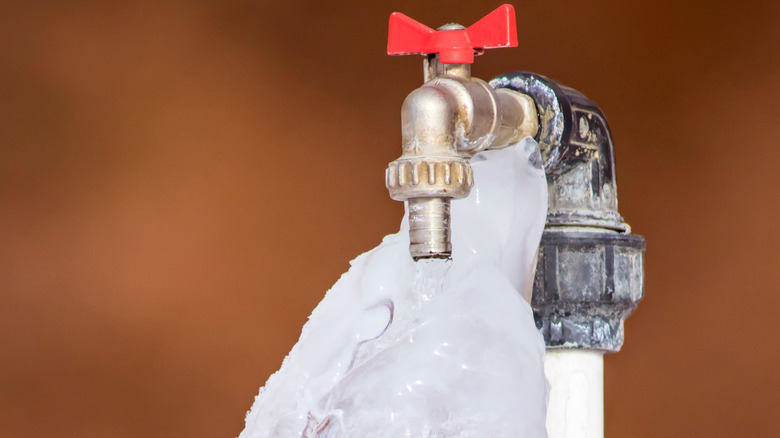Ways to Protect Pipes from Cold Weather: Expert Tips
Ways to Protect Pipes from Cold Weather: Expert Tips
Blog Article
The content further down in relation to Helpful Tips to Prevent Frozen Pipes this Winter is definitely insightful. Don't miss out on it.

Cold weather can ruin your plumbing, particularly by freezing pipes. Below's just how to prevent it from occurring and what to do if it does.
Intro
As temperature levels decrease, the danger of icy pipes rises, possibly leading to pricey fixings and water damages. Recognizing just how to stop icy pipes is critical for house owners in chilly climates.
Prevention Tips
Insulating vulnerable pipelines
Wrap pipelines in insulation sleeves or utilize warmth tape to shield them from freezing temperature levels. Focus on pipelines in unheated or exterior locations of the home.
Heating strategies
Maintain interior rooms appropriately heated up, particularly areas with plumbing. Open cabinet doors to enable warm air to distribute around pipelines under sinks.
Just how to determine icy pipelines
Seek reduced water flow from faucets, uncommon odors or sounds from pipelines, and visible frost on revealed pipelines.
Long-Term Solutions
Architectural modifications
Take into consideration rerouting pipelines away from outside wall surfaces or unheated locations. Include additional insulation to attics, cellars, and crawl spaces.
Upgrading insulation
Invest in high-quality insulation for pipes, attic rooms, and wall surfaces. Correct insulation helps keep consistent temperature levels and reduces the risk of icy pipelines.
Shielding Outdoor Pipes
Yard pipes and exterior faucets
Disconnect and drain garden hoses before wintertime. Set up frost-proof faucets or cover exterior faucets with protected caps.
Comprehending Icy Pipes
What creates pipelines to freeze?
Pipelines ice up when subjected to temperatures below 32 ° F (0 ° C) for expanded durations. As water inside the pipes ices up, it increases, putting pressure on the pipeline wall surfaces and potentially creating them to burst.
Dangers and damages
Icy pipes can result in supply of water interruptions, property damage, and expensive repairs. Burst pipelines can flooding homes and trigger extensive architectural damages.
Signs of Frozen Water Lines
Recognizing icy pipelines early can prevent them from breaking.
What to Do If Your Pipes Freeze
Immediate activities to take
If you suspect icy pipes, keep faucets open to soothe stress as the ice melts. Make use of a hairdryer or towels soaked in warm water to thaw pipelines slowly.
Verdict
Protecting against icy pipelines needs proactive steps and quick reactions. By comprehending the reasons, indications, and safety nets, home owners can secure their pipes during winter.
6 Proven Ways to Prevent Frozen Pipes and Protect Your Home
Disconnect and Drain Garden Hoses
Before winter arrives, start by disconnecting your garden hoses and draining any remaining water. Close the shut-off valves that supply outdoor hose bibs and leave the outdoor faucet open to allow any residual water to drain. For extra protection, consider using faucet covers throughout the colder months. It’s also important to drain water from any sprinkler supply lines following the manufacturer’s directions.
Insulate Exposed Pipes
Insulating your pipes is an effective way to prevent freezing. Pipe insulation is readily available at home improvement stores and is relatively inexpensive. Pay close attention to pipes in unheated areas such as the attic, basement, crawl spaces, or garage. Apply foam insulation generously to create a buffer against the cold. You can also wrap your pipes in heat tape or thermostat-controlled heat cables for added warmth.
Seal Air Leaks
Inspect your home for any cracks or openings that could let in cold air. Seal any holes around the piping in interior or exterior walls, as well as the sill plates where your home rests on its foundation. Additionally, make sure to keep your garage door closed unless you’re entering or exiting. Leaving it open creates a significant air leak that can lead to frozen pipes.
Allow Warm Air Circulation
During cold snaps, it’s essential to allow warm air to circulate evenly throughout your home. Leave interior doors ajar to promote better airflow. Open kitchen and bathroom cabinets to help distribute heat consistently around the rooms. If you have small children or pets, be sure to remove any household chemicals or potentially harmful cleaners from open cabinets for safety.
Let Faucets Drip
A small trickle of water can make a big difference in preventing ice formation inside your pipes. When temperatures drop significantly, start a drip of water from all faucets served by exposed pipes. This continuous flow helps prevent the water from freezing. Additionally, running a few faucets slightly can relieve pressure inside the pipes, reducing the chances of a rupture if the water inside does freeze.
https://choateshvac.com/6-proven-ways-to-prevent-frozen-pipes-and-protect-your-home/

As a fervent reader on 6 Ways to Prevent Frozen Pipes, I assumed sharing that segment was a good idea. Don't hesitate to take the opportunity to share this article if you enjoyed it. We appreciate reading our article about 6 Ways to Prevent Frozen Pipes.
Book Today Report this page